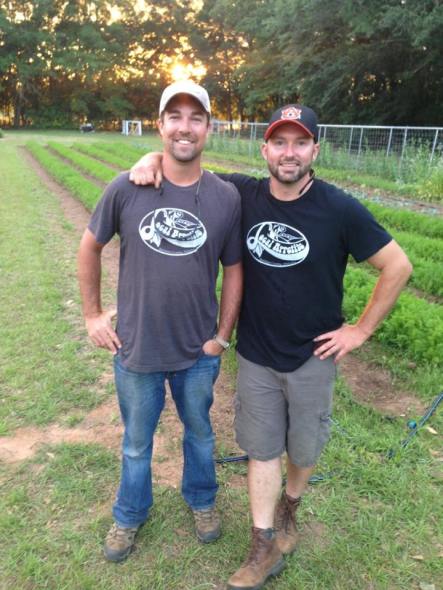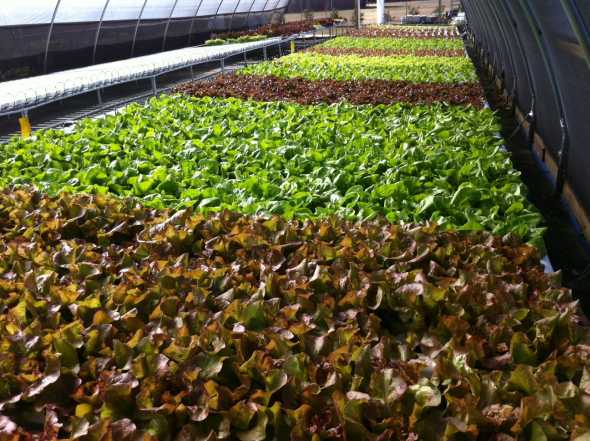Making The Move To Protected Agriculture

Will Mastin (right) and business partner Karl Brantley of Local Appetite market their produce to high-end restaurants and the occasional farmers market.
Photo credit: Local Appetite Growers

Will Mastin has been a busy man the past several years. Between officially launching his first operation, Local Appetite, and having to learn his way around new production systems, his hands have been quite full.
Although Mastin only formally formed an LLC with business partner Karl Brantley in 2012, he had been working behind the scenes for years, learning the ins and outs of production and fine-tuning the operation’s hydroponic systems before the business became official.
“I started growing on the side of my house just to experiment with hydroponics about five years ago,” Mastin says.
“We rented a piece of land behind our church and bought a used high tunnel structure from a farmer, and I started growing hydroponic lettuces and tomatoes in that.”
Local Appetite farms on 3½ acres in Fairhope, AL, which is just west of the Florida panhandle and nestled right atop the Gulf Coast.
Currently the operation has three high tunnels and one low tunnel where the primary cash crops are herbs, leafy greens, and tomatoes. The remaining acreage is dedicated to field-grown crops which include carrots, kale, beans, radishes, green onions, collards, Brussels sprouts, and cabbage.
Producing both in high tunnels and open-field allows Local Appetite to serve a variety of markets year-round and, perhaps most importantly, it allows them to navigate the notoriously challenging growing conditions on the Gulf Coast.
Highlighting Hydroponics
So why opt to grow under cover? Mastin explains the interest in hydroponics is what drove the adoption of covered production, but the benefits of producing under high tunnels have been far and wide-reaching.
“Where we are in the Gulf Coast, it’s a really volatile environment. There are a lot of crazy storms that come off the Gulf, and it rains every afternoon,” Mastin says.
“We’re growing high-value crops like lettuce and cherry tomatoes and the rain would cause all kinds of problems and mess up our harvest. We realized if we were going to grow something we had to bring to market every week, we had to have an attractive crop. To do that we needed the controlled environment of the high tunnel.”
The excessive heat that the Gulf experiences was even more incentive for Mastin to produce under cover. With the high tunnels, Mastin places shade cloth over the structures to help cool things down in the blazing summer months, allowing for an extended season.
High Tunnel Mechanisms
Hydroponic production and weather aside, Mastin says the exaggerated pest pressure in the Gulf Coast was further reason to get his crops under cover. With the warm, humid conditions nearly year-round, pests in the Gulf Coast are persistent and wide in range.
One innovative technique Mastin has employed to control pests in his tunnels is the use of woven shade cloth which he purchases from FarmTek and places on the sides of the tunnels to screen out larger insects.
“We’re taking 50% woven shade cloth and applying it to the sides of the tunnels, and we’ve actually gotten a few grants to help us do this. The cloth creates natural ventilation and helps keep out big bugs like moths — but not the smaller bugs like whiteflies, thrips, and flea beetles,” he says.
Studies are currently being done by Alabama state entomologist Ayanava Majumdar, who works closely with the operation and is currently researching which densities of shade cloths to use to help with pest exclusion.
“He’s done some studies on the different percentages, for example, between 20% and 50%, to see what is excluded by the different size shade cloths,” Mastin says.
To further spread the news, Mastin has made the rounds touting the benefits of shade cloth for pest exclusion, visiting various conferences, giving lectures, and hosting farm tours.
“The pest pressure in the South is a big deal, especially in the Gulf Coast, because we don’t have a hard winter that kills a lot of these pests. More and more growers are starting to realize they can use this technology.”

Local Appetite produces hydroponic lettuce and other leafy greens in high tunnels.
Photo credit: Local Appetite Growers
To Market, To Market
The operation primarily markets its produce to high-end restaurants, the occasional farmers’ market when there is enough produce, and is also selling a few CSA (Community Supported Agriculture) shares to interested customers. Mastin says he is certainly looking to increase his customer base, which he plans to do through face-to-face networking, and marketing through social media sites such as Facebook.
He’s also not shy about touting the local angle to potential customers.
“Local is everything we are. We grow hydroponically, and hydroponic fertilizer is not organic. Since we’re not organic, our angle is the freshest, most local produce that we harvest the day before it’s bought, so we try to push that angle really well,” Mastin says.
Low Risk, High Reward
Mastin has seen many advantages to high-tunnel production, and says that his investment in the structures has been well worth it.
Through a combination of being economical and growing high-value hydroponic crops such as lettuces, other leafy greens, and cherry tomatoes, Mastin says he was able to see the return in just a few years.
“With the hydroponics you’ve got a lot of electrical and plumbing and that kind of thing, so we’ve been trying to keep our overhead as little as possible,” he says.
As a word of advice, he suggests growers interested in high tunnels look into available grants from USDA’s Natural Resource Conservation Service and SARE (Sustainable Agriculture Research and Education Program), which he himself took advantage of.
To start out, however, Mastin says the most important thing any grower should do before producing in high tunnels is homework.
“Go visit other farmers and see what they’re doing. Do your research and start on a small scale to see if it works. You’ve got to put the time in and build your market. It takes a little while, but you’ve got to be patient and stick with it.”
Alexander is a freelance writer based in Colorado.









